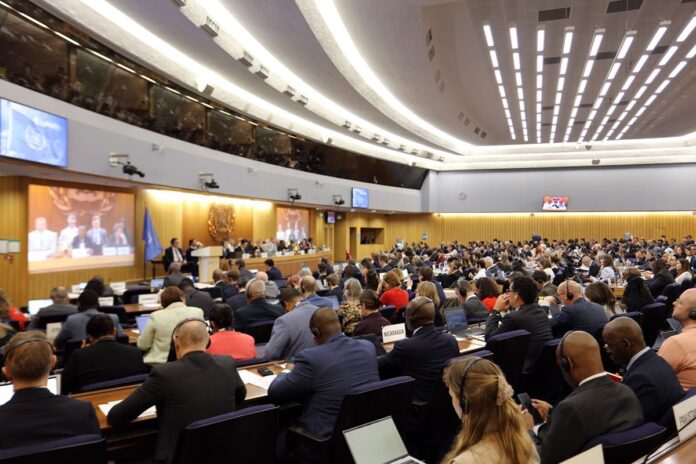The 83rd session of the International Maritime Organization’s (IMO) Marine Environment Protection Committee (MEPC 83), held last week in London, approved a draft global measure to address greenhouse gas (GHG) emissions from international shipping. This decision marks the first time the IMO has endorsed a binding market-based measure (MBM) for emissions pricing, alongside a fuel standard, and represents a significant shift in the regulatory landscape for the sector.
The framework is expected to be formally adopted at MEPC 84 in October 2025 and will enter into force in 2027, with enforcement of penalties commencing in 2028. It will apply to ships exceeding 5,000 gross tonnage (GT), which accounts for over 85% of global maritime GHG emissions. This measure introduces a two-tiered GHG fuel intensity standard, imposing financial penalties for non-compliance that will be directed to a newly established IMO Climate Fund. Ships that surpass the base emissions threshold will be required to pay $380 per tonne of CO₂ equivalent, with an additional $100 per tonne levied on emissions exceeding a stricter direct compliance target.
Revenue generated by this levy will be allocated to three key areas: 1) investment in zero- and near-zero-emission fuels and technologies; 2) support for developing countries, particularly Small Island and Developing States (SIDS) and Least Developed Countries (LDCs); and 3) broader climate mitigation measures across the maritime sector.
The outcome of MEPC 83 reflects years of complex negotiations and remains contentious. The EU and countries including China, Brazil, UK, and Canada have all supported the draft, indicating a convergence of interests among both developed and emerging economies. Notably, the United States abstained from the final decision and has since expressed strong opposition to the resolution. The US delegation cited concerns regarding potential trade impacts and the lack of alignment with its domestic regulatory framework.
Several Pacific Island states, including the Marshall Islands and the Solomon Islands, have also declined to endorse the agreement. They argue that it lacks the necessary ambition to limit global temperature increase to 1.5°C and fails to include a fixed global levy on GHG emissions. This proposal has been consistently advocated by the ‘6 Pac’ of small island nations: Fiji, Kiribati, Marshall Islands, Micronesia, Nauru, and Palau. ‘We cannot support an outcome that does not live up to the agreed strategy’, commented Solomon Islands’ Minister of Infrastructure Development, Manasseh Maelanga. ‘We will seek to improve this deal that unchanged will cause greater instability, and force shipping to continue polluting – that we can not accept.’
The decision to proceed with a majority vote, rather than by consensus in this case, represents a departure from traditional IMO practices and may set a precedent for future environmental rulemaking. While the adoption of a global carbon pricing mechanism is a significant regulatory development, questions persist about its effectiveness in incentivising the scaling up of zero-emission fuels. Green alternatives, such as e-methanol and ammonia, remain commercially uncompetitive, typically priced at two to four times higher than conventional VLSFO or LNG.
Analysis by the maritime consultancy UMAS suggests that, in its current form, the draft measure may deliver only an 8% reduction in emissions by 2030, which falls short of the IMO’s indicative target of 20% by the same year. According to their modelling, the IMO 20% target will be reached by 2033. Industry stakeholders have raised concerns that the resultant pricing signals may be inadequate to stimulate large-scale investment in the required infrastructure and vessel technology.
Nevertheless, the regulatory clarity offered by the framework is likely to facilitate investment planning, especially for shipowners and operators assessing long-term fleet renewal strategies. The IMO Climate Fund may also function as a crucial mechanism for de-risking early deployment of scalable zero-emission fuels (SZEFs) in key trade corridors.
Guy Platten, Secretary General of the International Chamber of Shipping, said: ‘We recognise that this may not be the agreement which all sections of the industry would have preferred, and we are concerned that this may not yet go far enough in providing the necessary certainty. But it is a framework which we can build upon. We will be studying the technical detail over the coming weeks, and will continue to support the IMO process so that we have a system that also works in company board rooms as well as the governments’ negotiating rooms.’
The precise design of the compliance mechanism and pricing structure is still under development. Key issues for further negotiation include the methodology for calculating well-to-wake GHG intensity; the criteria for fund disbursement; provisions for emissions trading or crediting; and mechanisms of enforcement and port state control. Further regional measures, including the EU ETS and FuelEU Maritime, will continue to apply in parallel, potentially creating compliance overlaps and administrative burdens for shipowners operating across multiple jurisdictions.
The IMO’s decision sends a clear signal that emissions from international shipping will be subject to increasing regulatory and financial scrutiny. However, its long-term impact will depend on the stringency of the final rules, the price levels implemented, and the effective governance of the Climate Fund. For the time being, the industry must navigate a transitional period characterised by policy uncertainty, high fuel price differentials, and significant infrastructure gaps.







